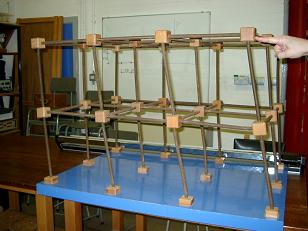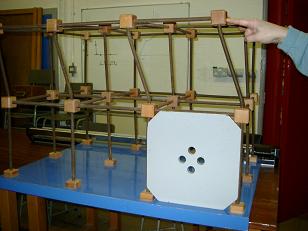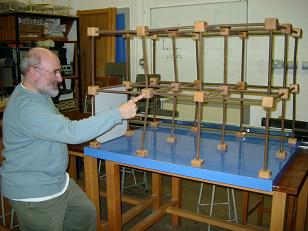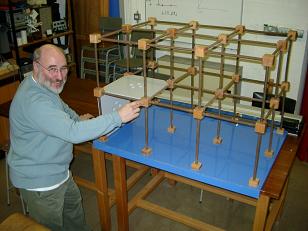Effect of shear force
This demonstration shows how lateral forces can be resisted and transmitted in frame structures through the use of shear elements, such as shear walls.




Fig. 5-8: Effect of shear walls
(The demonstration model was provided by Mr. P Palmer, University of Brighton)
Fig. 5-8a shows a three-dimensional frame system in which the columns and beams are made of steel springs with wooden joints linking the beams and columns. Applying a horizontal force to the top corner of the frame causes the frame to move in the direction of loading. It can be seen from Fig. 5-8a that the angles between beams and columns are no longer 90 degrees as was the case in the unloaded frame.
If a wooden board is fitted into a lower vertical panel of the frame as shown in Fig. 5-8b and the same force is applied as was the case in the last demonstration, it is observed that the upper story experiences horizontal or shear deformations while the lower storey is almost unmoved. The wood panel acts as a shear wall which has a large in-plane stiffness enabling it to transmit horizontal loads in the lower storey directly to the frame supports.
If the wooden board is replaced in a vertical plane in the lower part of one of the end frames as shown in Fig. 5-8c and a force is applied at the joint which is one bay away from the wooden board, it is observed that the frame to which the force is applied deforms significantly and the frame where the wooden board is placed has little movement.
If a further wooden board is placed in a horizontal plane, at first storey level, next to the vertical board as shown in Fig. 5-8d and a force is applied at the joint at the corner of the horizontal panel, it can be seen that there is little movement at the point where the force is applied. This is because the horizontal and vertical panels have large stiffnesses in their planes and the shear force is transmitted directly through the wooden boards to the supports.
